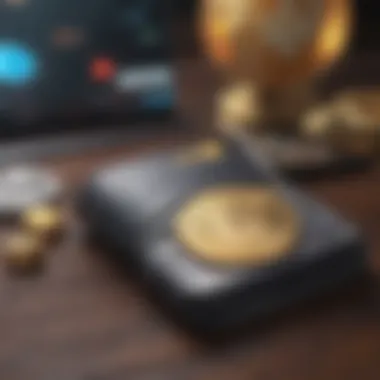Exploring NFT Wallets: Functions and Security Insights


Intro
Non-fungible tokens, commonly known as NFTs, have taken the digital world by storm, capturing the interest of collectors, artists, and investors alike. However, to navigate the captivating landscape of NFTs, one must first understand the tools of the trade, particularly NFT wallets. These wallets are essential for securely storing, managing, and transacting NFTs, and serve as the gateway to the world of digital collectibles and ownership.
NFT wallets differ from traditional wallets used for cryptocurrencies like Bitcoin or Ethereum, as they are tailored for assets that are unique and not interchangeable. This article aims to clarify the importance and functionality of NFT wallets, while also addressing security measures and best practices for managing non-fungible tokens. By diving deeper into this topic, both newcomers and seasoned enthusiasts will find practical insights into the ever-evolving world of blockchain technology.
Preamble to NFT Wallets
In this age where digital ownership is becoming increasingly relevant, NFT wallets have come to the forefront of the discussion. They are not just a trend; they represent a fundamental shift in how we perceive ownership in the digital realm. Simply put, NFT wallets allow users to store not just cryptocurrencies but also unique digital assets. The importance of understanding these wallets lies in their ability to empower users to navigate the complex landscape of non-fungible tokens.
What are NFT Wallets?
NFT wallets are specialized applications designed to store, manage, and transfer non-fungible tokens (NFTs). These tokens are unique digital assets, each with distinct properties that set them apart from others—think of them like fingerprints in the digital world. Unlike traditional cryptocurrencies, which are comparable to currencies in the physical world, NFTs can represent a wide array of items: digital art, collectibles, virtual real estate, and more.
NFT wallets can be either software-based or hardware-based. Software wallets are generally user-friendly and interact with various NFT marketplaces, while hardware wallets offer heightened security by storing the assets offline. Users can choose their wallet type based on preferences like convenience or security.
Importance in the Crypto Ecosystem
The role of NFT wallets in the broader crypto ecosystem cannot be overstated. They serve as a bridge between users and the world of non-fungible tokens, facilitating transactions, exhibitions, and ownership. As the popularity of NFTs rises, understanding wallet functionality is paramount.
Consider the following key points when examining their significance:
- Asset security: NFT wallets provide a secure environment tailored for digital assets. Users can store their NFTs safely, minimizing the risk of theft.
- Market connection: These wallets enable interaction with various marketplaces, simplifying buying, selling, and trading of non-fungible tokens.
- Ownership verification: NFT wallets help maintain a record of ownership, a crucial factor when dealing with unique digital assets. Ownership can be verified on the blockchain, providing authenticity.
The knowledge of NFT wallets is essential for anyone looking to dive into the world of cryptocurrencies, especially given the rise of digital art and unique digital assets.
In summary, NFT wallets are more than mere storage solutions—they are an essential part of the evolving landscape of digital ownership and cryptocurrency. With their varied types and capabilities, they cater to both seasoned investors and newcomers alike. Understanding NFT wallets serves as a critical step for anyone engaging with this disruptive force in technology.
Types of NFT Wallets
Understanding the different types of NFT wallets is crucial for anyone venturing into the world of non-fungible tokens. Each type serves distinct purposes and has its own strengths and weaknesses. Choosing the right wallet can significantly affect how you interact with NFTs, whether you’re minting, buying, or selling. As the NFT landscape continues to evolve, so does the technology behind these wallets. Thus, being informed helps in making smarter decisions, safeguarding your investments, and optimizing the overall user experience.
Hot Wallets
Hot wallets are often likened to keeping cash in your pocket. They’re always connected to the internet, which allows for quick access and transactions. Because they’re designed for ease of use, hot wallets tend to be favored by those who regularly buy or sell NFTs.
- Convenience: Hot wallets make transactions as easy as pie. Just a few clicks, and you’re ready to go.
- Variety of Options: Many hot wallets, like MetaMask and Trust Wallet, support a range of tokens and decentralized applications.
- User-Friendly Interfaces: If you’re not tech-savvy, these wallets often come with easy-to-navigate designs that can ease the learning curve.
However, the ease of access also comes with its fair share of risks. Being continually online exposes hot wallets to potential hacks. That’s why it’s wise to keep only limited amounts of NFTs or cryptocurrencies in these wallets, like putting just enough cash in your pocket for a night out.
Cold Wallets
Cold wallets, on the other hand, are similar to a bank vault. They are offline storage options, ideal for long-term holding and for those who prioritize security over convenience.
- Enhanced Security: Cold wallets are less susceptible to hacks since they aren’t connected to the internet. They're a good choice if you plan to hold valuable NFTs for an extended period.
- Hardware Wallets: Physical devices like Ledger and Trezor are popular examples of cold wallets. They store your keys offline and require physical access for transactions.
- Peace of Mind: Knowing your assets are tucked away in a secure location can be a huge relief.
The trade-off is that cold wallets can’t provide instant access. If you want to sell or trade quickly, you may find this type cumbersome, like trying to find that one specific coin in a jar.
Software vs. Hardware Wallets
When considering NFT wallets, a key differentiation arises between software wallets and hardware wallets. Both serve the basic function of storing NFTs and keys, yet they cater to different user preferences and needs.
- Software Wallets: These are typically hot wallets, existing in the form of mobile apps or browser extensions. They’re convenient for daily transactions but often exposed to security risks. Examples include Coinbase Wallet and Metamask.
- Hardware Wallets: As previously mentioned, these are cold wallets. They’re physical devices that store keys offline, drastically reducing vulnerability to hacks. They prioritize security over accessibility and are recommended for serious investors.
"Security is a top priority when dealing with assets in the digital world, and choosing between software and hardware wallets is fundamental in that regard."
In essence, choosing between a software wallet and a hardware wallet boils down to your specific needs. For those regularly engaged in trading, software wallets might be more suitable. For others holding valuable NFTs long term, opting for hardware wallets could be the way to secure peace of mind.
Setting Up an NFT Wallet
Setting up an NFT wallet is akin to laying the groundwork before embarking on a journey—it’s essential for anyone who wants to own, trade, or manage non-fungible tokens effectively. NFT wallets aren’t just safes for digital art or collectibles; they are gateways to a universe of blockchain-based possibilities. Choosing the right wallet, understanding how to install it correctly, and knowing how to handle private keys can give users an edge in this rapidly evolving landscape.


Choosing the Right Wallet for Your Needs
When it comes to NFT wallets, the selection is as diverse as the NFTs themselves. An informed choice can make all the difference. Consider the following types of wallets you might find in the wild:
- Hot Wallets: These connect to the internet and are user-friendly, ideal for beginners and frequent traders. However, being online can make them more vulnerable to hacks.
- Cold Wallets: These are offline storage solutions, like hardware wallets. They are more secure against cyber threats, suitable for storing high-value NFTs long-term.
Choosing the right wallet hinges on your personal needs:
- Frequency of Use: If you're planning on trading NFTs regularly, a hot wallet might serve you well. On the flip side, for long-term art collection, a cold wallet offers that peace of mind.
- Security Requirements: Assess how much risk you’re willing to take. If your NFT haul is considerable, leaning toward a cold storage solution is certainly wise.
- User Experience: Some wallets are more intuitive than others. Explore and see what feels right for you.
Step-by-Step Installation Process
Once you’ve chosen the right wallet, it's time to get things up and running.
- Download the Wallet: Make sure you download it from a reliable source. Avoid third-party websites where possible.
- Installation: Follow the onscreen instructions. This typically includes agreeing to the terms and selecting installation preferences.
- Create a New Wallet: After installation, you’ll be prompted to create a new wallet. This usually involves setting a password and obtaining a recovery phrase, which is crucial—don't skip this step! Keep your recovery phrase somewhere safe, perhaps even written down in a secure spot. If you lose it, accessing your funds can be a nightmare.
- Verify Installation: Most wallets will ask you to verify that you’ve recorded your recovery phrase correctly.
Importing and Exporting Private Keys
Understanding how to import and export your private keys is like wielding a double-edged sword. It can be powerful if used correctly, but the risks are significant. Here's what you need to know:
- Private Keys: These are what allow you to access your wallet and transact successfully. Never share them with anyone. Think of them as the keys to your vault.
- Exporting Your Private Key: This can be done from your wallet’s settings. Follow the prompts carefully. It’s advisable to do this only when necessary, like moving to a new wallet.
To export your private key securely:
- Go to your wallet settings.
- Find the option for Private Key Export.
- Follow the instructions provided, ensuring you’re in a secure environment.
- Store it securely and with caution.
- Importing Your Private Key: This comes in handy when you need to access a previously owned wallet or transfer it to another wallet. The steps typically involve:
- Opening your new wallet.
- Navigating to the import option in settings.
- Entering or pasting your private key carefully.
- You’ll often need to verify it.
In short, while setting up an NFT wallet seems like a straightforward process, it requires attention and care. Taking the time to choose the right wallet, following the installation process step-by-step, and handling your private keys safely are foundational to thriving in the NFT space.
"One of the biggest threats in the wallet space is neglecting security measures when handling private keys. Always treat them as sacred."
The rewards can be gratifying, but with great power comes great responsibility.
Security Considerations
In the realm of NFTs, securing your digital assets is not just a luxury; it's a necessity. NFT wallets, while providing a gateway to the exciting world of non-fungible tokens, also present unique security challenges that can pose risks if not properly managed. Addressing security considerations ensures that users can enjoy their digital art, collectibles, or virtual real estate with peace of mind.
Understanding Private and Public Keys
At the heart of any crypto wallet are the private and public keys, vital components that work together to provide security and functionality. The public key is akin to your bank account number. It’s shared widely so others can send you transactions or access specific content. In contrast, the private key is your personal password, should be kept strictly confidential to avoid unauthorized access.
Imagine if your private key were to slip into the wrong hands. The consequences could be dire. All the assets linked to that wallet could be claimed by someone else faster than you could say "digital heist." Thus, understanding the role of these keys is fundamental to any NFT enthusiast, be it a collector or a creator.
Common Security Risks
Even savvy users can find themselves in hot water if they are not aware of the risks surrounding NFT wallets. Here are some prominent threats to keep in mind:
- Phishing Attacks: Scammers often craft messages or websites that look legitimate, tricking users into revealing their private keys.
- Weak Passwords: Using simple passwords can leave doors open for trouble. Think of a password as your front door; the stronger it is, the less likely unwanted visitors can come in.
- Malware: Some software can surveil your computer, potentially harvesting sensitive information without your knowledge. Always ensure your device runs security software.
By being aware of common security risks, users can take proactive steps to safeguard their assets.
"An ounce of prevention is worth a pound of cure." - Benjamin Franklin
Best Practices for Wallet Security
To fully leverage NFT wallets while minimizing risks, adhering to best practices is essential:
- Use Hardware Wallets: Whenever possible, store your NFT assets in a hardware wallet, which keeps them offline and less vulnerable to hacks.
- Enable Two-Factor Authentication: Utilize two-factor authentication (2FA) wherever available, adding an extra layer of protection.
- Keep Software Updated: Regularly update your wallet software and any operating systems. Updates often contain critical security patches.
- Backup Your Wallet: Consistently create secure backups of your wallet and keep them in a safe space. It’s also good practice to change your keys periodically.
By following these strategies, users can mitigate risks and ensure their digital treasures remain secure, allowing them to focus on what truly matters—the unique experiences that NFTs bring.
Managing NFTs within the Wallet


Managing NFTs within your wallet is not just about storing digital assets; it's about maintaining a collection, ensuring accessibility, and maximizing the utility of your non-fungible tokens. The intricate relationship between NFT management and user experience cannot be overstated. A well-managed wallet simplifies interactions with NFTs, making the process more efficient and enjoyable. For enthusiasts, artists, and investors alike, understanding the nuances of this management is essential.
Adding and Creating NFTs
Adding and creating NFTs is a fundamental aspect of managing your digital collection. There are multiple platforms where you can mint your own NFTs; OpenSea, Rarible, or Mintable are among the popular choices. Each platform usually requires a wallet connection to operate effectively. Here’s how you can go about it:
- Choose a Platform: Select any of the aforementioned platforms based on your needs. Each offers unique functionalities. For instance, OpenSea allows for easy uploading of creations while Rarible might have a more community-driven approach.
- Connect Your Wallet: You will need to connect your NFT wallet to the chosen platform. Following the prompts should get you securely hooked up in no time.
- Upload Your Digital Asset: Once connected, you will find an option to create or mint a new NFT. Here, you can upload images, videos, art, or any digital file you wish to tokenize.
- Set Up Details: Provide key information about your NFT such as the title, description, and royalty fees if you plan to sell it.
- Mint the NFT: This process is where your digital asset becomes a unique token on the blockchain. After minting, you'll be able to see your newly created NFT in your wallet, ready for either showcasing or selling.
Take Note: Minting can incur gas fees, so ensure you have enough crypto in your wallet before proceeding.
Viewing and Managing Your Collection
Once you've added NFTs to your wallet, the next logical step is mastering the art of viewing and managing your assets. This process varies across wallets, but the underlying principles remain the same. Here’s what to consider when managing your NFT collection:
- User Interface: Familiarize yourself with your wallet's dashboard. A clear layout typically enables easier navigation through your assets.
- Filters and Sort Options: Most wallets allow users to filter items based on criteria such as price, rarity, or creation date. Use these tools to keep track of your collection more effectively.
- Regular Updates: Depending on the nature of the NFTs you hold, routinely check for updates on their value. Market dynamics can change rapidly, especially in the crypto space.
- Back-Up: Always back up your wallet information. Be it seed phrases or private keys, having a secure record ensures you can access your NFTs should anything happen to your device.
Managing NFTs is not merely an act of ownership but also involves strategy and knowledge. Having a robust understanding of these functions can enrich your experience in the ever-evolving world of digital assets. This meticulous approach to managing your collection ensures you're not just a passive holder but an active participant in the NFT marketplace.
Interacting with Marketplaces
Interacting with marketplaces is a crucial aspect of using NFT wallets. It allows users to engage in the buying and selling of non-fungible tokens, facilitating the vibrant ecosystem that surrounds digital assets. These marketplaces serve as the bridges that connect artists, collectors, and traders, fostering a lively environment where creativity and commerce intersect. Without a proper understanding of how to navigate these platforms, one may find themselves at a disadvantage, missing opportunities to acquire valued assets or sell their creations effectively.
In the realm of NFTs, the accessibility and functionality of marketplaces can directly impact an individual’s success in trading. Users must consider key aspects of these platforms, including user experience, fees, and supporting cryptocurrencies. Evaluating these elements can make all the difference when it comes to finding the right marketplace that aligns with one's needs and goals.
Connecting Your Wallet to NFT Marketplaces
When it comes to NFT marketplaces, connecting your wallet is a paramount step. Each marketplace usually boasts a unique integration process tailored for specific wallet types. On a broader scale, the process generally involves a few straightforward steps:
- Choose the Right Marketplace: This is the first decision you must make. Consider what type of NFTs you’re interested in—art? virtual real estate? collectibles? Some platforms specialize in particular kinds of NFTs. This can affect your options and selling opportunities.
- Access Wallet Settings: Once you've chosen a marketplace, head over to your wallet settings. Most wallets include a section to manage integrations and connections. It might feature an option like "Connect Wallet".
- Select Your Wallet Type: Marketplace platforms often support various wallet options. Common wallets include MetaMask, Coinbase Wallet, and Fortmatic. Select your wallet from the provided list.
- Authorize Connection: After selecting your wallet, you'll be prompted to authorize the connection. This usually involves signing a message to confirm it's you.
- Sign In to the Marketplace: Once authorized, you can return to the marketplace, where your connected wallet will now reflect your NFT holdings, allowing for seamless interactions.
"The connection between your wallet and the marketplace is akin to unlocking the door to a treasure trove of digital assets. Without it, you are merely outside looking in."
After getting your wallet linked, it’s wise to familiarize yourself with the marketplace’s user interface. Each platform may differ in layout and options available. Taking the time to explore this upfront can save confusion later on.
Buying and Selling NFTs
Navigating the buying and selling process of NFTs requires understanding the ins and outs of transactions in these digital marketplaces. The following outlines some key points to keep in mind:
Buying NFTs
When seeking to purchase an NFT, it’s essential to consider:
- Research the creator: Understanding who created the NFT adds value to your investment. Take a moment to review their portfolio, background, and prior work.
- Check the price history: Look for past sales and current listings. Historical data can indicate trends in value, helping you decide whether to proceed.
- Evaluate community trust: Some marketplaces will have user ratings or feedback on transactions. A vibrant community of users can speak to a platform's reliability.
Buying doesn’t just stop at pressing a button; it involves due diligence, much like any investment.
Selling NFTs
If you’re looking to part with your digital assets, the following points are vital:
- Set realistic pricing: Determine a fair price based on market trends. This requires being in tune with current demand for similar NFTs.
- Craft a compelling listing: Include detailed descriptions and engaging visuals to attract potential buyers. Presentation matters, as you want to stand out from the crowd.
- Engage with buyers: Be timely in responding to queries. A proactive approach can build rapport and trust between you and prospective buyers.
Cross-Chain NFT Wallets
As the world of non-fungible tokens continues to evolve, the concept of cross-chain NFT wallets has become increasingly vital. These wallets are not merely a convenience; they represent a significant leap in achieving versatility and accessibility across various blockchain platforms. Understanding cross-chain wallets is critical for anyone looking to maximize their investment potential and ensure that their digital assets remain fluid and adaptable in a rapidly changing ecosystem.
What Are Cross-Chain Wallets?
Cross-chain wallets facilitate the transfer and management of NFTs across multiple blockchain networks. Unlike traditional wallets constrained to a single blockchain, these wallets offer the flexibility to interact with a variety of protocols, each with its unique characteristics. This means that a user can hold NFTs minted on Ethereum, Binance Smart Chain, and Polygon all in one place.
For instance, if a user owns an NFT from a gaming platform on Ethereum but wants to sell it on a marketplace that primarily works with Binance Smart Chain, a cross-chain wallet provides the necessary functionality without the hassle of transferring assets manually between different wallets. In other words, it acts as a bridge, enabling seamless interaction with diverse ecosystems.


Benefits of Using Cross-Chain Solutions
The advantages of cross-chain solutions are numerous and compelling:
- Enhanced Flexibility: Users are not tied to one blockchain, allowing them to optimize their collections based on market trends. This adaptability is crucial in the fast-paced NFT environment.
- Wider Market Access: By supporting tokens from various blockchains, collectors can list their NFTs on multiple marketplaces, increasing their exposure and potential sales opportunities.
- Reduced Fees: By allowing transactions across blockchains, users can sometimes leverage lower gas fees on one platform compared to others. This ability could save a significant amount in transaction costs over time.
"The future of NFTs lies in adaptability; cross-chain wallets are an essential tool for anyone serious about maximizing their digital holdings."
- Interoperability: As more blockchains emerge and existing ones expand, cross-chain functionality ensures that NFTs can maintain their value and utility across different platforms.
- Unified Experience: Managing multiple wallets can be cumbersome. Cross-chain wallets simplify the user experience, allowing for a centralized management system of diverse digital assets.
In a nutshell, embracing cross-chain NFT wallets can empower users to navigate the NFT landscape more effectively, enriching their digital experience while ensuring their investments remain relevant in a multifaceted crypto world.
The Future of NFT Wallets
The role of NFT wallets is evolving rapidly, and understanding their future brings to light some fascinating dynamics in the ever-shifting landscape of digital assets. As we peer into this future, we find significant advancements backing the usability, security, and integration of NFTs into everyday transactions and experiences. This topic serves as a cornerstone for readers keen on investing, educating themselves, or merely understanding where the intersection of NFTs and wallets is headed.
Emerging Trends and Technologies
The winds of change are blowing in the NFT realm, giving rise to a few trends and technologies that consumers and investors should keep an eye on.
One notable trend is the integration of artificial intelligence in NFT wallets. This is not just about flashy technology; it’s about making wallets smarter. Imagine a wallet that could analyze market trends and suggest optimal times for trading NFTs. Such capabilities would empower users, particularly those who might not have extensive market knowledge.
Blockchain interoperability is another trend making waves. The ability for different blockchains to communicate with each other is crucial for the future of NFT wallets. It paves the way for cross-platform functionality, which could enable users to manage NFTs across various ecosystems without the hassle of juggling multiple wallets.
Here are a few key technologies gaining traction in the NFT wallet arena:
- Multi-chain Support: Supporting multiple blockchains directly in wallets enhances versatility.
- Decentralized Identity Solutions: Enhancing user privacy and control over their own data.
- Social Recovery Mechanisms: Empowering users to recover wallets securely through trusted contacts, alleviating fears over losing access.
The Role of Decentralized Finance
Decentralized Finance, often shortened to DeFi, is crafted to innovate traditional financial systems. As it intersects with NFT wallets, it opens a whole new ball of opportunities. Users can experience a seamless merging of assets—think about leveraging NFTs to access liquidity through decentralized lending platforms.
Moreover, NFT wallets are set to become the linchpin for fractional ownership of digital assets. This means that instead of owning an entire NFT, users may soon own portions, democratizing access to high-value digital art or assets that were previously out of reach for many. This democratization is aligned closely with the ethos of both DeFi and NFTs, focusing on inclusivity.
"Decentralization is more than a buzzword; it signifies a shift toward a more equitable financial landscape, allowing users unprecedented control over their assets."
So, how might NFT wallets evolve alongside DeFi? Here are potential shifts to look out for:
- Wallet interfaces that facilitate DeFi interactions seamlessly.
- Integration with decentralized exchanges for in-wallet trading.
- Enhanced functionalities for staking NFTs to earn yields.
As this fusion between NFT wallets and DeFi moves forward, users can expect a more holistic toolkit for managing both elements of their crypto portfolios. Overall, the future of NFT wallets seems poised to reshape how we think about ownership, accessibility, and the way we interact with digital assets.
Finale
Wrapping up this exploration of NFT wallets, it’s crucial to recognize their transformative role within the realm of cryptocurrencies. As the digital landscape evolves, understanding the nuances of how these wallets operate becomes paramount for anyone engaged with non-fungible tokens. The insights gathered throughout the article highlight several key elements.
Firstly, security cannot be overstated. With the rise of digital assets comes an equivalent rise in threats, and ensuring the safekeeping of one’s NFTs demands informed choices about wallet types and practices. This understanding arms investors, analysts, and enthusiasts alike with the tools to safeguard their investments against potential pitfalls.
Secondly, the significance of cross-chain wallets emerges as a game changer. The adaptability and functionality they offer not only broaden the horizons of NFT interactions but also reflect the interconnected future of blockchain tech. Embracing these innovations enhances liquidity and accessibility across various platforms, allowing users to navigate the waters of the digital art and collectibles market with ease.
In addition, as decentralized finance (DeFi) continues to gain traction, it reshapes how users perceive NFT wallets. They are no longer just storage solutions but active components in complex financial ecosystems. Understanding this evolution allows investors to leverage their assets for borrowing, lending, or farming, thus maximizing the potential of their digital collections.
Finally, the article illustrates that being proactive about wallet management and understanding the ecosystem you're engaging with can’t be overlooked. The differences between hot and cold wallets signify the choices users need to make based on their individual needs. Basic operational knowledge will allow users to maneuver through the intricacies of the marketplace and manage their NFTs effectively.
"The future of NFT wallets is intertwined with the growth of the digital economy, presenting endless possibilities for innovation and application."
In sum, this conclusion reiterates that NFT wallets are fundamental to navigating the evolving landscape of digital ownership and investment. By immersing oneself in this knowledge, one positions themselves favorably in a rapidly developing market, ready to adapt and thrive in the face of change.
Key Takeaways
- Security is paramount: Choose wallets based on your level of engagement and investment.
- Cross-chain interactions: Embrace wallets that support multiple networks to diversify your holdings.
- NFT wallets as financial tools: They offer more than just storage; consider their use in DeFi opportunities.
Final Thoughts on NFT Wallets
As we conclude, it's evident that NFT wallets serve as essential facilitators in the growing digital art and collectibles ecosystem. They are more than mere repositories; they symbolize ownership, access, and potential engagement within a diversified portfolio.
Understanding and choosing the right wallet necessitates research and consideration of both current needs and future possibilities. As the NFT space continues to evolve, investors equipped with knowledge will find themselves well-prepared to navigate its challenges and opportunities. Staying informed and adaptable in this shifting landscape will prove invaluable for anyone looking to make their mark in the digital economy.



